- Home
- Encyclopedia
- The Lynching of Edward Woodson, 1918
The Lynching of Edward Woodson, 1918
[Editor’s note: In the contemporary coroner’s report and news items quoted directly in this article, the N-word appears several times. We have used dashes to spell most of the word.]
It began with a bowl of mush and ended in the murders of two men—one shot through the heart, the other lynched by a vicious mob. And the following night—though news reports conflict on this—nearly the town’s entire African-American population may have fled.
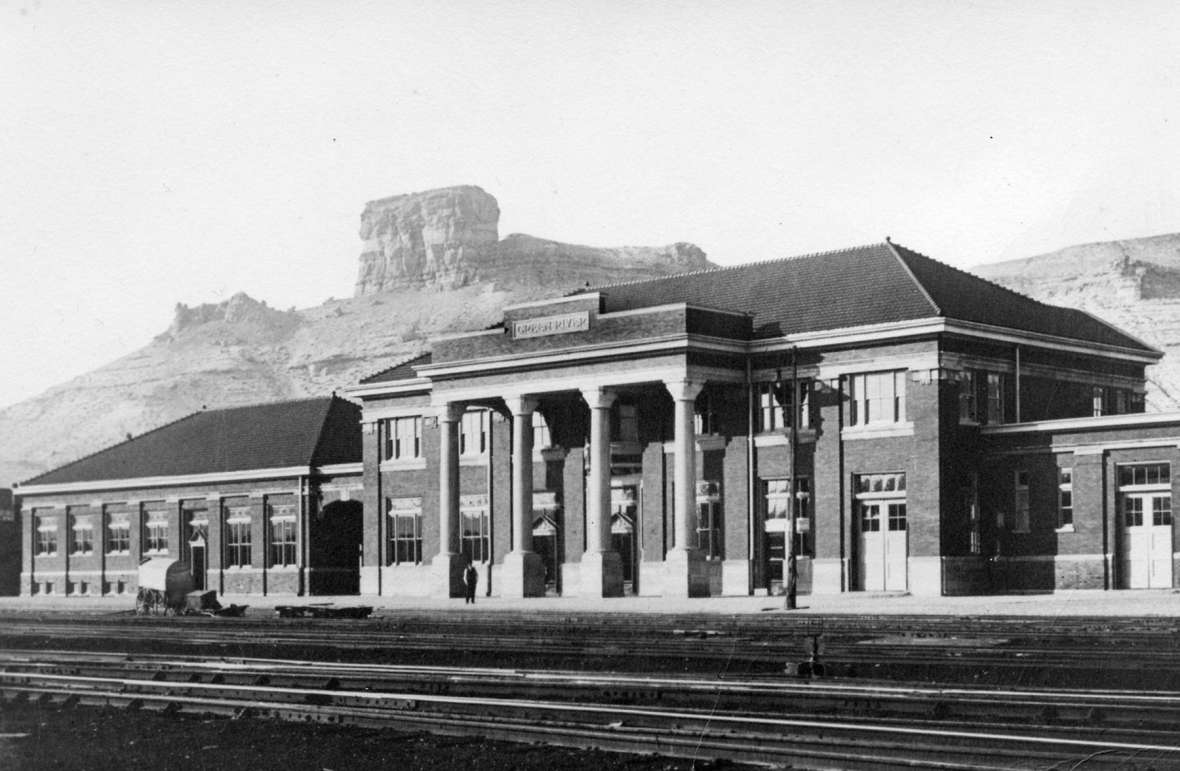
Edward Woodson, an African-American Union Pacific porter and janitor with a wife and family in Omaha, Neb., had been working at the train station in Green River, Wyo., for about three months on the morning of Dec. 10, 1918, when he sat down at the depot’s meal counter to order his breakfast.
When the waitress, Evelyn Ware, brought Woodson a bowl of corn meal mush, he became angry. He’d ordered sausages, he said, and the race-based chain of events that would end in his death began. The deeply ingrained bigotry of the time was front and center during her testimony a week later, on Dec. 17, at the inquest called by Joseph Joynson, the Sweetwater County coroner. Ware testified as follows:
“This n----r came in and ordered corn meal mush and I brought him the mush and he said: “I didn’t order that, I ordered sausage.” I said: “I didn’t hear you.” He said: “You are a liar.”
“When he said that I picked up three salt shakers and hit him in the face with them. I told him it was bad enough to take abuse from white men, but I wouldn’t take it from a n----r. I told him to get up and get out, that I wouldn’t wait on him.
“When I said that Mr. Miller [Union Pacific switchman N.E. Miller who, like Woodson, had arrived in Green River about three months before] took him [Woodson] out the door. Then he [Woodson] came back in again and sat down in the center of the counter where the head waitress was waiting on the counter and ordered breakfast from her.
“He sat there for a few minutes and Mr. Miller said to me: ‘Evelyn, if I were you I wouldn’t come back in here; I believe he has a gun, but you need not get worried, I am not afraid of him if he had twenty guns.’ Then, I believe the n----r went out and Mr. Miller followed him out and the n----r shot him.”
Ethel Harris, a cashier at the nearby Union Pacific Hotel, was at the meal counter for her own breakfast. She testified that “I didn’t notice him [Woodson] being in there until she [Evelyn Ware] picked up something and threw it at him. Mr. Curtis [another Union Pacific switchman] and Mr. Miller got up and they took him by the arm and got him out of there. Mr. Miller came back and talked to me a while and then Mr. Curtis came up and Mr. Miller said: ‘Come Curtis, let’s go to our room,’ and after they went out I heard the shots.” She confirmed that she’d heard three shots, then said “When the n----r came in the second time and sat three seats to the left of me, after finishing my breakfast, as he went out the door he stuck his hand in his coat and I could see the gun.”
Switchman George M. Lemmons, another witness to events at the meal counter, testified in much the same vein:
“I went over to the eating house at about 10:30 and as I walked in there Miller told this n----r: ‘You had better get up and get out of here before you get in trouble; that isn’t any way to talk to a lady, she couldn’t help your order.’ He [Woodson] sat there sat there and Miller said to him: 'Come on get out of here,’ and asked me to open the door.'
“He and the n----r walked out and I walked in and gave my order of eggs and toast and she gave it to me. She said she was getting enough bawling out from white people and would not stand it from a n----r, and told him to get up and get out of there. Pretty soon the n----r came back again and must have been seven or eight stools from where I was to my left, he set there and she did not wait on him.
“The n----r got up and left there and Miller and Curtis stood there talking to me and the Cashier and they started out and I said I would go over to the Club to read a while. Just as Curtis started to open the door he commenced to shoot, and Curtis started to grab the gun. He shot Miller and he fell and then shot him once more on the ground and then started shooting at me.
“Curtis ran in there and I tied a handkerchief on his arm. The n----r started to run and went in the lumber yard. I was going to get him before he got away; I was going to get a gun and I ran in three different places trying to get a gun, until I was out of wind and someone said to me to call up the Sheriff’s Office. I told them to get the Sheriff, that I was out of wind. The Special Officers [Union Pacific Special Agents Matt McCourt and John C. Gale] were after him and it didn’t take long for them to get him.”
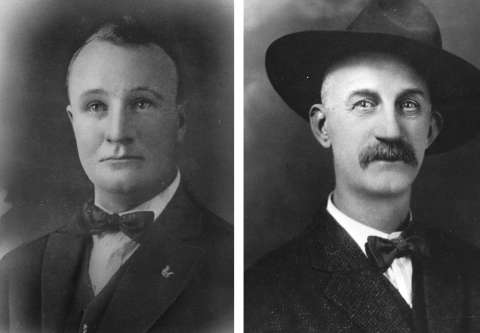
Woodson apparently went to his quarters after leaving the meal counter for the second time and armed himself with a Colt .45 revolver. When Miller and Curtis walked out, he shot Miller twice in the chest and Curtis once in the wrist. Curtis survived, but Miller died at the scene. Dr. J.W. Hawk, a local physician, later examined Miller’s body and described the cause of death:
“I examined him and found two gun shot wounds in his left breast, one just in the neighborhood of the left nipple and the other below, four inches over the heart; shot from the front, both of them. The bullets did not come thru [sic]; the bullets both lodged in the body. . . the low one went thru [sic] the heart, the other one [also] would have probably proved fatal.”
Two Union Pacific special agents—fully empowered and armed law enforcement officers—were in their offices in the train station at the time of the shooting: John Gale and Matt McCourt; the latter had served as sheriff of Sweetwater County from 1907 to 1916. McCourt heard the shots fired and, looking out the window, “saw this man running up the street with a big gun in his hand.” The two agents gave chase and found Woodson in the Peters Lumber Yard, several blocks away. As McCourt later testified:
“He [Woodson] was coming towards me and I saw the gun in the front pocket of his pants. I put my hand up to him and pulled my gun. He pulled his gun and then said: ‘Alright, that is enough,’ and walked over and handed it to me. He never said a word. I said to him: ‘Come on with us.’ There were four or five men behind us and I hurriedly brought him up to the jail, and during the time we were bringing him up here he never spoke. We turned him over to the Sheriff and he was put in the County Jail.”
Asked if Woodson was “of a quarrelsome nature,” McCourt replied, “I have never heard of him being in any fight; I think he was a little quick tempered at times.”
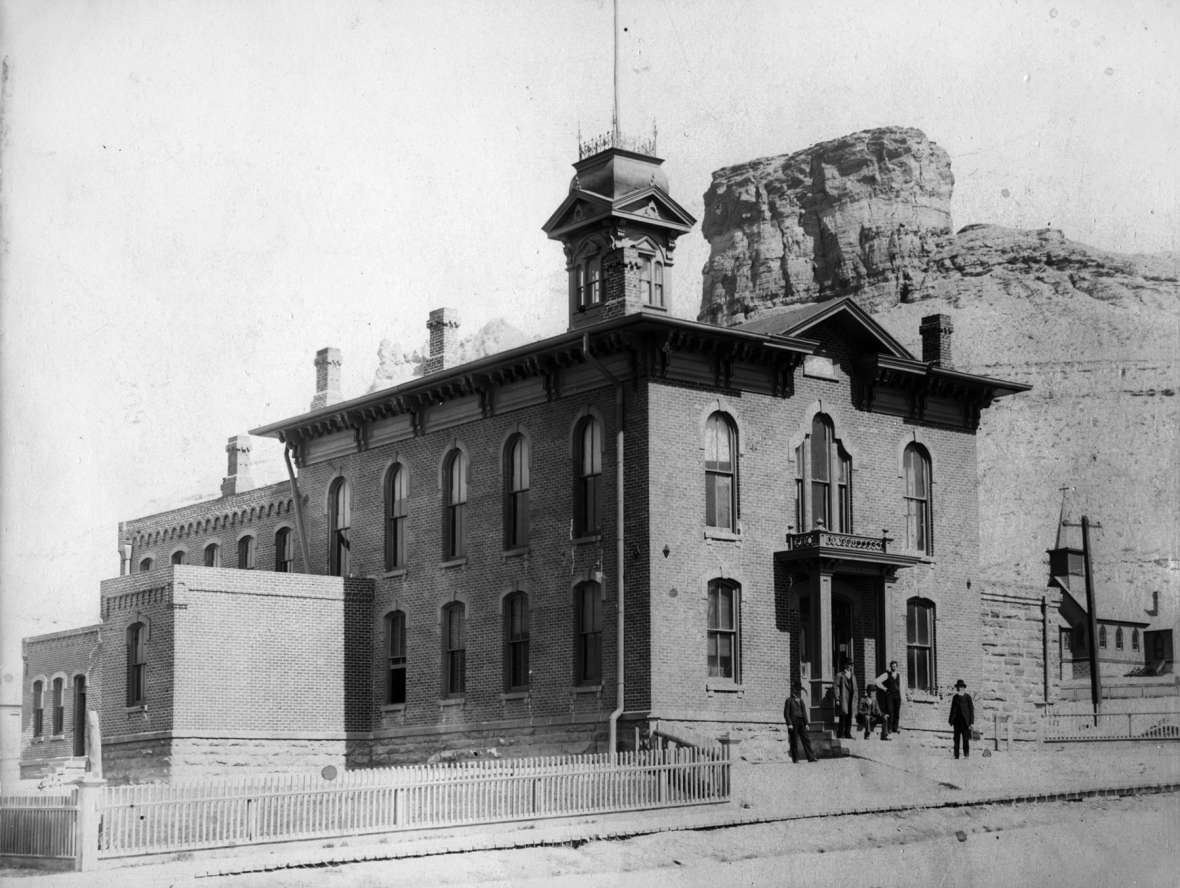
At the county courthouse, sheriff’s office and county jail, on Sage Street, (now North Center Street), McCourt and Gale turned Woodson over to Deputy Sheriff Frank Kidd, who testified later:
“There was quite a bunch coming up the street then. Someone got a key and locked the front door, they were yelling out there. Mr. Dixon [Sweetwater County Sheriff Arthur Dixon] came in and said: ‘We had better get rid of him.’ We put him in the basement and I got him down in the coal bin and told him to stay there, because if those fellows got him they might hang him. He [Woodson] said: ‘It is just as well now as any time.’
“They would not have found him if he had stayed where I told him to, but there is a light hanging right over the boiler and he came out and stood right under this light and someone must have looked thru the window, and they went down and got him and I never saw him after until he was hanging on the pole... in front of the depot.”
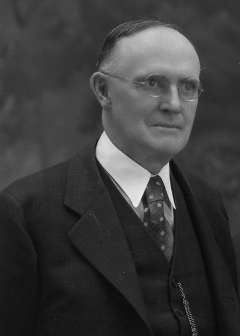
Kidd completed his testimony with a claim that he hadn’t recognized anyone in the crowd.
Sheriff Arthur Dixon testified that he and Kidd took Woodson to the building’s coal bin in the basement to keep him out of the hands of the mob, which he estimated to number “four or five hundred.” He said he tried to put the mob off by letting four of them to go through the jail to confirm he wasn’t there, but “they pushed right in on us.”
He said he hadn’t recognized anyone in the crowd, either.
The Green River Star reported that “Attorney T.S. Taliaferro who was at the courthouse attempted to pacify the crowd by addressing them, but the infuriated crowd was beyond reasoning, and the negro being discovered in the coal hole of the heating plant of the jail, where he had been hidden by the officers, he was seized and dragged to the depot and hanged to a light pole in front of the depot, where it hung until the arrival of the coroner from Rock Springs. Ten minutes after the hanging the town was quiet and no further demonstration was made.”
In the matter of Edward Woodson’s death, on Dec. 27, 1918, Coroner Joynson’s inquest ruled:
“We, the jury duly empannelled [sic] and sworn by Joseph Joynson, Coroner for Sweetwater County, State of Wyoming, after due investigation, and consideration, in to the death of one Edward Woodson, colored, met his death by an unknown mob and being lynched on Dec. 10th, 1918 at Green River, Wyoming. We therefore find that said Edward Woodson came to his death by hanging by an unknown mob.”
With the exception of Union Pacific Special Agent Matt McCourt and Sheriff Arthur Dixon, every witness at the inquest, as well as one of the jurors who asked a question, used the N-word, often repeatedly.
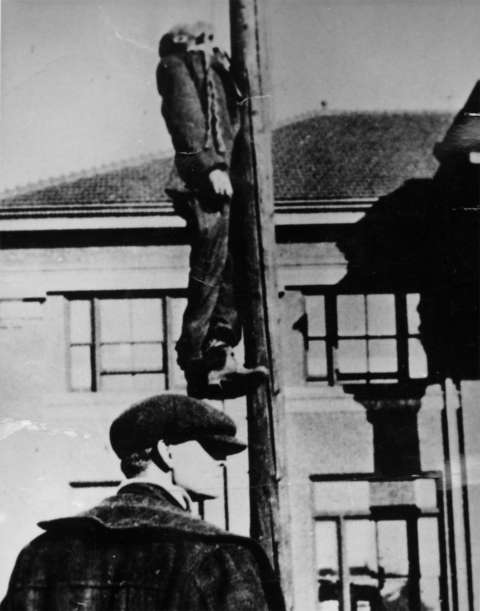
Though Sweetwater County Attorney Fred W. Johnson said he would call a grand jury “to investigate who had a hand in the lynching and will probe the matter to the fullest extent,” no one was ever charged in Woodson’s lynching.
The Green River Star’s report was anything but subtle in its vindication of the mob:
“The popularity of the two switchmen, brought about the high trend of excitement that existed, and the cold blooded manner in which the deed was done, made it utterly impossible to save the negro murderer from the infuriated mass of humanity that surrounded the jail. The officials seeing that they had no time to get the negro away, hid him as stated above, but when found by the crowd no power could have saved him from these determined avengers of the death of their friend.”
According to an Ogden, Utah, newspaper, as many as 25 African-American families fled Green River 36 hours after the lynching, fearing more violence and having been warned or even ordered to do so; they left all their belongings behind and left by train. Papers in Kemmerer and Sheridan, Wyo,. quickly picked up the story. But in the same issue, the Ogden Evening Standard reported that Green River Mayor J. W. Hawk and Union Pacific Railroad officials “emphatically denied” any Black families had left Green River, adding that “All race feeling, if there was such, ended with the lynching of the negro Tuesday night,” and the town had been quiet since. Ogden is a railroad hub on the UP line about 150 miles west of Green River.
That might have ended the rumor of an exodus, if it was a rumor. But from Laramie, 225 miles east of Green River, Laramie Republican reported two days after the lynching, apparently from its own sources—“Train men arriving this morning—” that there were “no negroes” left in Green River, “they having heeded the warning to leave the community.”
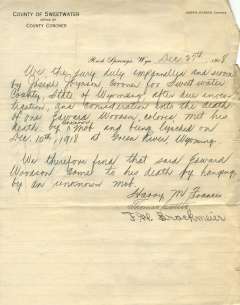
Census figures may in fact show that’s what happened. In the decade between 1910 and 1920, while the population of nearby Rock Springs grew by nearly 12 percent and Sweetwater County by 40 percent, Green River’s population shrank by 3.5 percent.
In any case, Woodson’s death came toward the end of an intense decade and a half in Wyoming of lynchings of Black men. By the 1910s, according to scholar Todd Guenther, Wyoming was lynching Black men at a rate 30 times as great as was occurring at the same time in the deep South. Guenther concluded these were crimes meant not just to punish individuals, but to terrorize a population. Whether the African-Americans of Green River fled, or stayed or some combination of both options, it’s fair to assume all feared for their lives.
No one would claim that Woodson gunning down Miller was anything but murder. But “Other men were murdered in and around Green River in those years and their killers received fair trials,“ Guenther observed in a 2009 Annals of Wyoming article on Woodson’s case and other lynchings. “Law and order as enforced by vigilante justice was not the objective of this racially preoccupied mob.”
Nine days after the murder and lynching, the Wyoming State Tribune in Cheyenne published a letter from Presbyterian Minister Russell Taylor, one of the founders of Empire, Wyo., near Torrington, an agricultural, African American community by this time 10 years old.
Woodson had “acted unwisely,” noted Taylor, first in what he said to the waitress, and second in returning to the restaurant with a gun—if in fact the reported facts were true. “And therein lies the injustice of the mob’s act,” Taylor continued. “The world knows nothing of the other side . . .”
If there had been a trial, “if Woodson could have told his story, the state whose motto is equal rights before the law would not have been again disgraced by another terrible lynching,” continued Taylor, whose own brother had died in police custody in Torrington a few years earlier. “Five hundred men would not be guilty of murder as they now are, though the law seems to take no cognizance of the fact.”
Resources
Primary Sources
Newspapers
- “Colored Families Are Not Driven Out.” Ogden Daily Standard, Dec. 12, 1918, accessed via Utah Digital Newspapers, March 2, 2021.
- “Driving Out the Colored People.” Ogden Daily Standard, Dec. 12, 1918, accessed via Utah Digital Newspapers, March 2, 2021.
- “Few Negroes Left.” Laramie Republican, Dec. 12, 1918, p. 6, accessed via Wyoming Digital Newspapers Collection, March 2, 2021.
- “The Green River Lyncheing [sic].” Wyoming State Tribune, Dec. 19, 1918, p. 2, accessed via Wyoming Digital Newspapers Collection, March 2, 2021.
- “Have Left the Town.” Laramie Republican, Dec. 12, 1918, p.1, accessed via Wyoming Digital Newspapers Collection, March 2, 2021.
- “Lynching at Green River.” Kemmerer Republican, Dec. 13, 1918, accessed via Wyoming Digital Newspapers Collection, March 2, 2021.
- “Murder and Lynching at Green River Tuesday.” Rock Springs Miner, Dec. 13, 1918.
- “Negroes forced to Leave Green River Following Hanging.” Sheridan Enterprise, Dec. 12, 1918, p. 8, accessed via Wyoming Digital Newspapers Collection.
- “No News of Exodus of Negro Families." Ogden Daily Standard, Dec. 12, 1918, accessed via Utah Digital Newspapers, March 2, 2021.
- “Surrendered to the Mob.” Laramie Republican, Dec. 11, 1918, p. 11, accessed via Wyoming Digital Newspapers Collection, March 2, 2021.
- “Switchman Shot – Another Wounded - Negro Lynched.” Green River Star, Dec. 13, 1918.
Coroner’s reports
- “In the matter of the death of Edward Woodson (Colored).” Sweetwater County Coroner’s Report, Dec. 27, 1918. Sweetwater County Historical Museum, Green River, Wyo.
- “In the matter of the death of N.E. Miller.” Sweetwater County Coroner’s Report, Dec. 10, 1918. Sweetwater County Historical Museum, Green River, Wyo.
Secondary Sources
- Guenther, Todd. “‘The List of Good Negroes:’ African American Lynching in the Equality State.” Annals of Wyoming 81, no. 2, (Spring 2009): 2-33.
- U.S. Census Bureau. “Historical Decennial Census for Wyoming Counties, Cities and Towns,” accessed March 2, 2021 at http://eadiv.state.wy.us/demog_data/cntycity_hist.htm. From 1910 to 1920, Rock Springs grew from 5,778 to 6,456 people; Sweetwater County grew from 8,455 to 11,575; Green River’s population fell from 1,361 to 1,316.
Illustrations
All photos are from the collections of the Sweetwater County Historical Museum in Green River, Wyo. Used with permission and thanks.
